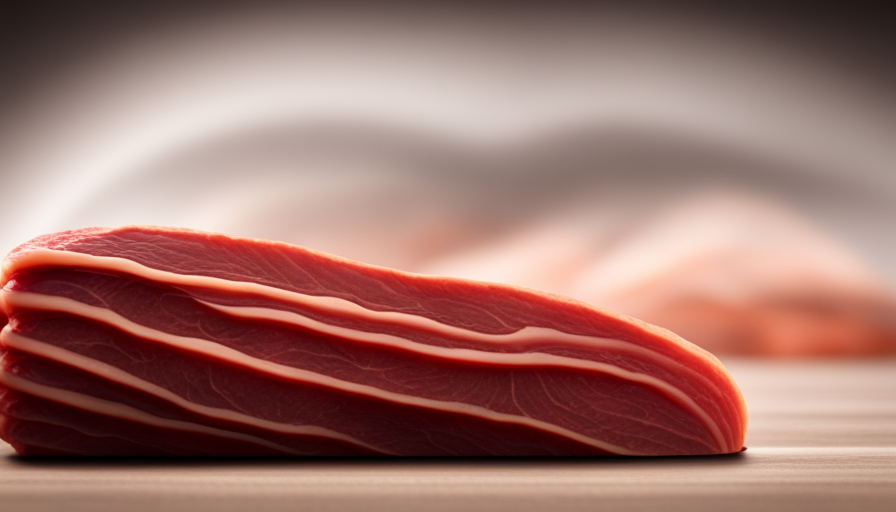Have you ever pondered what the term ‘lean’ truly signifies when you encounter it on the food label of raw beef?
Well, lean beef refers to a specific nutritional quality that can have a significant impact on your overall health. As a nutrition enthusiast and a firm believer in the power of a balanced diet, I am here to shed light on the importance of understanding this label and making informed choices when it comes to your food.
In this article, we will explore the definition of ‘lean’ in food labeling, the nutritional benefits of choosing lean beef, and how to identify lean cuts of beef. We will also discuss the health implications of consuming lean beef, common misconceptions, alternatives to lean beef, and tips for making informed choices at the grocery store.
So, let’s dive in and discover the world of lean beef and its role in promoting a healthy lifestyle.
Key Takeaways
- Lean beef refers to raw beef with low fat content, specifically less than 10g total fat, 4.5g or less saturated fat, and less than 95mg cholesterol per 100g.
- Choosing lean beef reduces unhealthy fat intake and provides high-quality protein, iron, and zinc.
- Lean beef is a healthier option for weight management and lower fat intake, as it has lower fat content and higher protein compared to other cuts.
- Incorporating lean beef into a balanced diet provides essential nutrients and supports heart health, muscle building, and nutrient absorption.
Understanding the Definition of ‘Lean’ in Food Labeling
So, if you’re curious about what ‘lean’ really means on a food label for raw beef, let’s dive right in and clear things up for you!
When it comes to food labeling, the term ‘lean’ refers to the nutritional value of the product. In the case of raw beef, it indicates that the meat contains a relatively low amount of fat. To be labeled as ‘lean,’ beef must have less than 10 grams of total fat, 4.5 grams or less of saturated fat, and less than 95 milligrams of cholesterol per 100 grams. These criteria are based on the dietary guidelines provided by health authorities.
Choosing lean beef has several nutritional benefits. First and foremost, it helps reduce the intake of unhealthy fats, which can contribute to heart disease and other health problems. Lean beef is also a good source of high-quality protein, essential vitamins, and minerals such as iron and zinc. It can be a valuable part of a balanced diet, providing important nutrients while keeping fat intake in check.
So, now that you understand the definition of ‘lean’ on a food label for raw beef, let’s explore the nutritional benefits of choosing lean beef and how it can support a healthy lifestyle.
Nutritional Benefits of Choosing Lean Beef
When it comes to choosing lean beef, there are three key nutritional benefits to consider. First, lean beef has a lower fat content compared to other cuts, making it a healthier option for those looking to reduce their fat intake.
Second, lean beef is higher in protein, which is essential for muscle growth and repair.
Lastly, lean beef is a rich source of essential nutrients such as iron, zinc, and vitamin B12, which are necessary for maintaining good health.
Lower Fat Content
With a lower fat content, lean raw beef is a healthier option for those seeking a visually appealing and nutritious meal. Choosing lean beef aligns with dietary guidelines for lower calorie consumption, making it an excellent choice for weight management and overall health. Lean beef typically contains less than 10 grams of total fat per 100 grams, which is significantly lower compared to regular beef. To illustrate the nutritional benefits of lean beef, consider the following table:
| Nutrient | Amount per 100g |
|---|---|
| Calories | 150 |
| Total Fat | 6g |
| Saturated Fat | 2g |
| Protein | 26g |
| Iron | 15% DV |
As you can see, lean beef is not only lower in fat but also a good source of protein and iron. Transitioning to the next section, lean beef also offers a higher protein content, which is essential for muscle growth and repair.
Higher Protein Content
Boost your muscle growth and repair with the higher protein content found in lean beef. Protein is essential for building and repairing muscle tissue, making it an important nutrient for those looking to increase their protein intake.
Lean beef is a great source of high-quality protein, containing all the essential amino acids necessary for muscle growth. With its lower fat content, lean beef provides a leaner option for those wanting to maintain a balanced diet while still meeting their protein needs.
Incorporating lean beef into your diet can be easy with a variety of delicious lean beef recipes available.
Next, let’s explore the essential nutrients found in lean beef that contribute to overall health and well-being.
Essential Nutrients
Packed with a powerhouse of vital nutrients, lean beef is a mouthwatering feast that nourishes your body and fuels your zest for life. Not only is lean beef a great source of protein, but it also provides essential nutrients that promote weight loss and bone health. In fact, a 3-ounce serving of lean beef contains approximately 154 calories, 22 grams of protein, and is rich in vitamins and minerals such as iron, zinc, and B vitamins. These nutrients play a crucial role in maintaining a healthy weight, supporting muscle growth and repair, and promoting bone density. Incorporating lean beef into your diet can help you achieve your weight loss goals while providing the necessary nutrients for strong and healthy bones. Transitioning into the subsequent section about the health implications of consuming lean beef, it is important to understand the benefits and potential considerations when incorporating this nutrient-dense food into your diet.
Health Implications of Consuming Lean Beef
When it comes to weight management, consuming lean beef can be beneficial. This is due to its high protein content and low fat content. The protein in lean beef helps to increase feelings of fullness and boost metabolism, making it easier to maintain a healthy weight.
Additionally, lean beef is a good source of nutrients like iron and zinc. These nutrients are important for heart health and muscle building and recovery.
Weight Management
To maintain a healthy weight, it’s important to check the lean content on the food label of raw beef. By understanding the lean content, you can make informed decisions about portion control and weight loss goals.
Here are four key points to consider when it comes to weight management and lean beef:
-
Lean beef is an excellent source of high-quality protein, which can help you feel fuller for longer and support muscle growth and repair.
-
Choosing lean cuts of beef can be beneficial for weight management as they contain less fat and fewer calories compared to fattier cuts.
-
Incorporating lean beef into a balanced diet can provide essential nutrients like iron, vitamin B12, and zinc, which are important for overall health.
-
Pairing lean beef with a variety of vegetables and whole grains can create balanced meals that promote satiety and support weight loss efforts.
Considering the impact of lean beef on weight management, it’s crucial to also address its benefits for heart health.
Heart Health
When it comes to weight management, watching what you eat is crucial. But it’s not just about calories and portion sizes; it’s also about making heart-healthy choices.
As we transition into discussing heart health, let’s delve into the importance of lean cuts of beef. Lean beef is not only low in fat, but it also contains essential nutrients like protein, iron, and zinc. By incorporating lean beef into your diet, you can support heart disease prevention and maintain healthy cholesterol levels.
Research suggests that lean beef can help reduce LDL (bad) cholesterol levels, which is a key risk factor for heart disease. So, next time you’re at the grocery store, opt for lean cuts of beef to support your heart health.
Now, let’s move on to the next section and explore how lean beef can aid in muscle building and recovery.
Muscle Building and Recovery
If you’re looking to build muscle and aid in recovery, incorporating lean cuts of beef into your diet is a smart choice. Not only does lean beef provide high-quality protein that helps to repair and rebuild muscle tissue, but it also contains essential amino acids that are crucial for muscle recovery.
Additionally, lean beef is rich in vitamins and minerals that support overall nutrient absorption, such as iron, zinc, and vitamin B12. These nutrients play a vital role in muscle function and energy production, which are essential for optimal performance during workouts and recovery afterward.
By including lean cuts of beef in your diet, you can ensure that your body gets the necessary nutrients to build and repair muscles effectively.
Moving forward, let’s explore how to identify lean cuts of beef.
Identifying Lean Cuts of Beef
Discover the secret to choosing the leanest cuts of beef for your next meal and maximize your health with a single glance at the food label. When it comes to identifying lean cuts of beef, understanding the nutritional value and cooking methods is crucial.
A food label on raw beef can provide important information about the fat content and overall quality of the meat. Look for keywords such as ‘lean’ or ‘extra lean’ on the label, as these indicate lower fat content. Additionally, pay attention to the percentage of fat listed, aiming for cuts that contain less than 10% fat.
Cooking methods also play a role in minimizing the fat content of beef. Opt for grilling, broiling, or roasting as these methods allow the fat to drip away from the meat. Trimming visible fat before cooking can further reduce the overall fat content.
Incorporating lean beef into a balanced diet is essential for maintaining optimal health and muscle building. By choosing lean cuts of beef and preparing them using healthy cooking methods, you can enjoy the nutritional benefits of beef without compromising your diet.
Incorporating Lean Beef into a Balanced Diet
Incorporating lean beef into a balanced diet is like adding a strong foundation to a towering skyscraper, providing the necessary building blocks for optimal health and muscle development. Lean beef is not only a great source of protein but also provides essential nutrients like iron, zinc, and B-vitamins. It is particularly beneficial for individuals aiming for weight loss as it is low in fat and calories. When it comes to cooking methods, it is important to choose ones that retain the nutritional value of the beef while minimizing added fats. Grilling, broiling, and roasting are excellent options as they allow the fat to drip away. Another cooking method to consider is stir-frying, which uses minimal oil. To emphasize the importance of incorporating lean beef into a balanced diet, let’s take a look at the following table:
| Cooking Method | Fat Content | Calorie Content |
|---|---|---|
| Grilling | Low | Moderate |
| Broiling | Low | Moderate |
| Roasting | Low | Moderate |
By choosing these cooking methods and incorporating lean beef into our meals, we can achieve our weight loss goals while still enjoying delicious and nutritious meals. Considering environmental and ethical factors, it is important to explore alternative protein sources as well.
Considering Environmental and Ethical Factors
When considering the environmental and ethical factors of incorporating lean beef into a balanced diet, it’s important to focus on sustainable farming practices. These practices ensure that the production of beef doesn’t harm the environment or deplete natural resources.
In addition, it’s crucial to consider animal welfare standards. These standards guarantee that the animals are treated humanely throughout their lives.
Furthermore, choosing local and organic options is also important. This not only supports local farmers but also reduces the carbon footprint associated with long-distance transportation.
Sustainable Farming Practices
Sustainable farming practices play a crucial role in ensuring that the lean beef found on food labels is a result of environmentally-friendly and ethical farming methods. By implementing sustainable farming techniques, such as rotational grazing and organic feed, farmers can minimize their environmental impact.
Rotational grazing allows livestock to graze in specific areas for a limited time, which prevents overgrazing and soil erosion. Organic feed ensures that the animals are not exposed to harmful chemicals or genetically modified organisms. These practices not only promote healthier ecosystems but also reduce the carbon footprint associated with beef production.
Transitioning to sustainable farming methods allows for the production of lean beef that is not only nutritious but also aligns with environmental and ethical values. These environmentally-friendly practices set the stage for the subsequent section on animal welfare standards, which further contribute to the overall sustainability of the beef industry.
Animal Welfare Standards
After discussing sustainable farming practices, it’s important to delve into another crucial aspect of food production: animal welfare standards.
When it comes to the beef industry, ensuring the well-being of the animals is paramount. Animal welfare standards encompass a range of practices that prioritize the health, comfort, and humane treatment of livestock. This includes providing adequate space, access to clean water and nutritious food, and minimizing stress and pain during handling and transportation.
Sustainable farming practices go hand in hand with animal welfare standards, as a healthy and well-cared-for animal is more likely to contribute to a sustainable and ethical food system. By prioritizing animal welfare, farmers can not only provide consumers with high-quality and ethically produced beef, but also contribute to a more sustainable and environmentally friendly industry.
Now, let’s explore the availability of local and organic options for those seeking even more sustainable choices.
Local and Organic Options
If you’re looking for a more sustainable choice, you can sink your teeth into the local and organic options, which are like a breath of fresh air for the conscious consumer.
Local sourcing is a key aspect of these options, as it reduces the carbon footprint associated with long-distance transportation. By supporting local farmers, we also contribute to the growth of our community and promote a stronger local economy.
Organic farming, on the other hand, offers numerous benefits. It avoids the use of synthetic pesticides and fertilizers, ensuring that the beef is free from harmful chemicals. Organic farming also promotes soil health and biodiversity, which in turn improves the overall quality of the meat.
By choosing local and organic options, we not only make a positive impact on our environment but also enjoy the superior taste and nutritional value of lean beef.
As we dive into the next section about common misconceptions, it’s important to understand the value of these sustainable choices.
Common Misconceptions about Lean Beef
When it comes to lean beef, there are several common misconceptions that need to be debunked.
First, it is important to address the stereotype that lean beef is tasteless or dry. This is simply not true, as lean beef can be just as flavorful and juicy as other cuts of meat.
Additionally, concerns about hormones and antibiotics in beef production should be addressed, as many people worry about the potential health effects of consuming these substances.
Finally, understanding the overall nutritional profile of lean beef is crucial, as it’s a great source of essential nutrients such as protein, iron, and B vitamins.
Debunking Stereotypes
To debunk stereotypes, imagine yourself standing in front of a food label on a package of raw beef, and you see the term ‘lean’ indicating the low fat content of the meat. It’s important to understand that lean meat doesn’t necessarily mean it’ll aid in weight loss. Here are four key points to consider:
-
Caloric Content: While lean meat may be lower in fat, it still contains calories. If you consume excessive amounts, it can hinder your weight loss goals.
-
Portion Control: Even lean meat should be consumed in moderation. Overeating can lead to an excess calorie intake, hindering weight loss efforts.
-
Balanced Diet: Relying solely on lean meat won’t guarantee weight loss. A balanced diet that includes a variety of nutrient-rich foods is crucial for overall weight management.
-
Exercise: Incorporating regular physical activity is essential for weight loss, and it complements a diet that includes lean meat.
By addressing concerns about hormones and antibiotics, we can further explore the potential impact of these factors on our health.
Addressing Concerns about Hormones and Antibiotics
Now that we’ve debunked some stereotypes surrounding the consumption of lean beef, let’s address the nutritional concerns that consumers may have, particularly regarding hormones and antibiotics.
It’s important to note that the use of hormones in beef production is strictly regulated by the U.S. Food and Drug Administration (FDA). In fact, the use of added hormones in beef cattle is not permitted in several countries, including the European Union.
As for antibiotics, they’re used judiciously and responsibly in beef production to ensure the health and well-being of the animals. Strict withdrawal periods are followed to ensure that no residues are present in the meat.
It’s understandable that consumers have preferences when it comes to their food choices, but it’s crucial to have accurate information to make informed decisions. Understanding the overall nutritional profile of lean beef will help address any remaining concerns.
Understanding the Overall Nutritional Profile
Imagine sinking your teeth into a succulent, perfectly grilled steak, savoring the rich flavors while knowing that you are also nourishing your body with a protein-packed meal. Understanding the overall nutritional profile of lean beef is essential, especially if you are watching your weight or following dietary guidelines. Lean beef is known for its lower fat content, making it a healthier option for those seeking weight loss. To better comprehend its nutritional value, let’s take a closer look at the table below:
| Nutrient | Amount per 100g |
|---|---|
| Protein | 26g |
| Fat | 5g |
| Calories | 150 |
| Cholesterol | 70mg |
As you can see, lean beef is a great source of protein, while being relatively low in fat and calories. Incorporating lean beef into your diet can support weight loss goals and meet dietary guidelines for protein intake. However, if you are looking for alternatives to lean beef, there are other options available that can provide similar benefits.
Alternatives to Lean Beef
Explore the flavorful options available as you seek alternatives to lean beef. Incorporating lean beef into a balanced diet is important, but it’s also good to have variety and explore other protein sources.
One alternative to lean beef is poultry, such as chicken or turkey. These options are generally leaner and can be prepared in a multitude of ways, from grilling to baking.
Another option is fish, which is not only high in protein but also rich in omega-3 fatty acids that are beneficial for heart health. Salmon, tuna, and trout are great choices.
Plant-based proteins, like beans, lentils, and tofu, are also excellent alternatives. They are high in fiber and can be incorporated into various dishes, adding a different texture and flavor.
Lastly, consider trying venison or bison, which are lean meats that offer a unique taste.
By exploring these alternatives to lean beef, you can add variety and nutrition to your diet.
Transitioning now to making informed choices at the grocery store, it’s important to know how to identify the best options for your health.
Making Informed Choices at the Grocery Store
When it comes to making informed choices at the grocery store, there are several key points to keep in mind. First, it’s important to read and compare labels to understand what you’re purchasing. This involves looking at the nutrition facts, ingredients list, and any health claims.
Additionally, shopping for budget-friendly options can be achieved by comparing prices, buying in bulk, and opting for store brands.
Lastly, seeking recommendations from health professionals, such as nutritionists or dietitians, can provide valuable insights and guidance when it comes to making the best choices for your health and nutrition needs.
Reading and Comparing Labels
Reading and comparing labels can be a helpful way to find out the amount of lean meat in raw beef, as the saying goes, ‘You are what you eat.’
When it comes to understanding serving sizes, it’s important to note that the label on raw beef typically provides information per serving size, which is usually measured in ounces or grams. By comparing the serving sizes of different brands or cuts of beef, you can determine the amount of lean meat you’re getting. Additionally, deciphering ingredient lists can provide valuable information about the quality and nutritional content of the beef. Look for labels that list lean cuts of beef with minimal additives or preservatives.
Understanding these aspects of label reading can help you make informed choices and select the most nutritious options.
Transitioning into shopping tips for budget-friendly options, it’s important to keep in mind that lean beef doesn’t have to break the bank.
Shopping Tips for Budget-Friendly Options
Now that we know how to read and compare labels, let’s talk about some shopping tips for budget-friendly options. When it comes to choosing lean beef, it’s important to find a good balance between quality and cost. One way to do this is by planning your meals ahead of time and incorporating budget-friendly recipes into your meal rotation. This will help you make the most of your ingredients and minimize waste. Additionally, consider buying in bulk or looking for sales and discounts to save money. To further assist you with your budget, I have created a table below with some meal planning tips to help you stretch your dollar. By being mindful of your budget and planning ahead, you can make healthier choices without breaking the bank. Speaking of healthier choices, let’s now move on to seeking recommendations from health professionals.
Seeking Recommendations from Health Professionals
If you’re serious about making healthier choices for your budget, don’t hesitate to consult health professionals for their valuable recommendations. They can provide you with expert advice tailored to your specific health risks and dietary restrictions. Health professionals, such as nutritionists or dietitians, have extensive knowledge about the nutritional content of foods and can guide you towards lean options that meet your needs.
When it comes to raw beef, seeking recommendations from health professionals is particularly important. Raw beef can vary in its fat content, and consuming excessive amounts of saturated fat can increase the risk of heart disease and other health problems. Health professionals can advise you on the leanest cuts of beef and recommend cooking methods that minimize fat content.
Consulting health professionals is crucial when making food choices, especially when it comes to raw beef. Their expertise can help you navigate the health risks associated with different cuts and ensure that you find budget-friendly options that align with your dietary restrictions.
Transitioning into the next section, it’s important to understand the importance of lean beef in a healthy diet.
Conclusion and Final Thoughts on the Importance of Lean Beef in a Healthy Diet
Incorporating lean beef into your diet is essential for a delectable journey towards a healthier lifestyle. Not only does lean beef provide a satisfying and flavorful option for meat lovers, but it also offers numerous benefits for weight management and heart health.
When it comes to weight management, lean beef is an excellent choice. It’s packed with high-quality protein, which helps increase satiety and reduce overall calorie intake. Additionally, lean beef contains essential nutrients like iron, zinc, and B vitamins, crucial for maintaining a healthy metabolism and promoting energy production.
Furthermore, lean beef can contribute to heart health. It’s a great source of monounsaturated fats, which have positive effects on cholesterol levels and reduce the risk of heart disease. By incorporating lean beef into your diet, you can enjoy a tasty meal while also taking care of your cardiovascular health.
In conclusion, lean beef is a valuable addition to a healthy diet. Its benefits for weight management and heart health make it an excellent choice for those seeking to improve their overall well-being. So, why not savor the deliciousness of lean beef while reaping the rewards it offers to your body?
Frequently Asked Questions
How is the ‘lean’ percentage calculated on a food label of raw beef?
To calculate the lean percentage on a food label of raw beef, it is essential to determine the lean content in different cuts. This involves measuring the ratio of lean meat to fat present in the cut. The lean percentage is calculated by dividing the weight of the lean meat by the total weight of the cut, including any visible fat. This method ensures accurate labeling and provides consumers with valuable information about the nutritional content of the beef.
Are there any regulations or guidelines for labeling beef as ‘lean’?
There are regulations on labeling beef as ‘lean’ in order to provide consumers with accurate information about the nutritional value of lean beef. These regulations ensure that the lean percentage is calculated using specific guidelines.
The nutritional value of lean beef is determined by its fat content, which is generally lower than regular beef. By adhering to these regulations, consumers can make informed choices about the lean beef they purchase.
Can the lean content of raw beef vary depending on the cut?
The lean content of raw beef can vary depending on the cut. It’s important to note that lean beef can be substituted for other types of lean protein in a diet. When comparing the lean content of raw beef to other meats, it’s generally lower in fat and higher in protein. This makes lean beef a desirable choice for those looking to reduce their fat intake while still obtaining a good source of protein.
Are there any health risks associated with consuming lean beef?
There are several health benefits associated with consuming lean beef. It’s a good source of protein, which is essential for muscle growth and repair. Lean beef also provides important nutrients such as iron, zinc, and B vitamins. Additionally, it’s lower in fat and calories compared to fattier cuts of beef, making it a healthier option for those watching their weight or managing certain health conditions. Incorporating lean beef into a balanced diet can contribute to overall nutritional value.
Is lean beef a suitable option for individuals following a specific diet, such as a low-fat or low-calorie diet?
Lean beef is a suitable option for individuals following a specific diet, such as a low-fat or low-calorie diet. Compared to fatty beef, lean beef contains less fat and calories, making it a healthier choice. Including lean beef in a balanced diet provides numerous benefits. It’s a great source of protein, vitamins, and minerals, while being low in saturated fat. This can aid in weight management, muscle building, and overall health.
Is “Lean” in a Food Label of Raw Beef the Same as “Lean” on a Food Label Package of Raw Beef?
When you see “lean” on a food label of raw beef, it means the beef has less than 10 grams of total fat, less than 4.5 grams of saturated fat, and less than 95 milligrams of cholesterol per 100 grams serving. This is the same meaning of lean raw beef whether it’s on the package or the label.
Conclusion
In conclusion, lean beef is a nutritious choice that can enhance a healthy diet. It’s low in fat and high in protein, making it an ideal option for those looking to maintain a balanced lifestyle. By incorporating lean cuts of beef into meals, individuals can enjoy the benefits of essential nutrients while keeping their calorie intake in check.
Remember, when shopping for lean beef, be sure to look for labels that clearly indicate the percentage of fat content. So, seize the opportunity to savor succulent, slender, and sensational lean beef!










